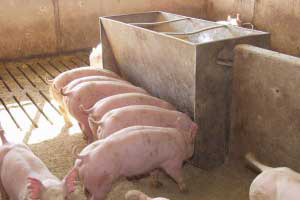Study: Fat digestibility in pig diets

Pork producers need accurate information on the energy value of fat in feed ingredients to ensure that diets are formulated economically and in a way that maximises pork fat quality. Researchers at the University of Illinois have determined the true ileal and total tract digestibility of fat in four corn co-products, as well as in full fat soybeans and corn oil.
Hans H. Stein, a professor of animal sciences at U of I, led the team of researchers in the study in which they looked at four corn co-products: distillers dried grains with solubles (DDGS), high-protein distillers dried grains (HP DDG), corn germ, and a high-oil corn that contained about 7% lipids. They also tested full-fat soybeans and extracted corn oil.
Three diets were formulated containing each source of oil, as well as a basal diet that contained no added fat. These diets were fed to cannulated pigs. The apparent ileal and total tract digestibility of lipids in each diet was calculated and a regression procedure was used to estimate endogenous losses and to calculate the true ileal digestibility and the true total tract digestibility of lipids.
“We observed that the digestibility of oil in soybeans is much greater than in the corn co-products. It appears that pigs can utilise that oil much more easily,” Stein said.
He attributed this to differences in the way fat is stored in the ingredients. “In soybeans, you have almost 20% fat, and therefore a lot of that fat is just stored as regular triglycerides, and relatively easy to get to. In the other ingredients, in particular the corn germ and the DDGS, some of the fat is encapsulated by fibre, which makes it more difficult for the enzymes to digest.”
According to study results, the true ileal digestibility of corn oil was greatest at 95.4%. Among intact sources of fat, the fat in full-fat soybeans (85.2%) and HP DDG (76.5%) was the most digestible. Digestibility of fat was lowest in DDGS (62.1%), high-oil corn (53.0%), and corn germ (50.1%).
Corn oil also had the greatest true total tract digestibility at 94.3%. Full-fat soybeans had the next greatest digestibility at 79.7%. HP DDG was next at 70.2%. Finally, DDGS (51.9%), corn germ (43.9%), and high-oil corn (41.4%) had the lowest true total tract digestibility.
Stein said the results of the research were in agreement with several previous experiments indicating that the energy value of some ingredients was less than would be expected based on their lipid content. “But now we have an explanation because we realize that pigs don’t digest those lipids very well so it doesn’t necessarily help that these products have higher concentrations of oil,” he said.
“From a nutritional point of view, there would be a clear advantage if we could first extract the fat and then add it to the diet as corn oil rather than leave it in the ingredients. Whether such an approach would be economical would depend on the cost of extracting the oil from corn germ and other ingredients,” Stein said.
The study, “In growing pigs, the true ileal and total tract digestibility of acid hydrolysed ether extract in extracted corn oil is greater than in intact sources of corn oil or soybean oil,” was published in the Journal of Animal Science.











